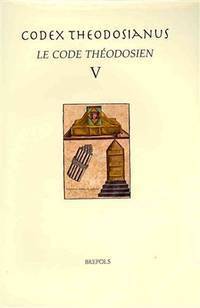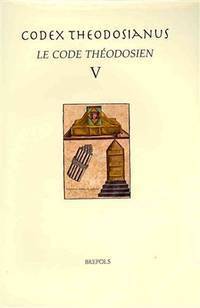- Work (Individual)
- 2009
- Λατινικά | Γαλλικά
-
- n 50039501 ⟶ Codex Theodosianus
-
- Q4300 ⟶ Codex Theodosianus
-
- 174176271 ⟶ Codex Theodosianus
-
-
The Codex Theodosianus ("Theodosian Code") is a compilation of the laws of the Roman Empire under the Christian emperors since 312. A commission was established by Emperor Theodosius II and his co-emperor Valentinian III on 26 March 429[1][2] and the compilation was published by a constitution of 15 February 438. It went into force in the eastern and western parts of the empire on 1 January 439. The original text of the codex is also found in the Breviary of Alaric (also called Lex Romana Visigothorum), promulgated on 2 February 506.
On 26 March 429, Emperor Theodosius II announced to the Senate of Constantinople his intentions to form a committee to codify all of the laws (leges, singular lex) from the reign of Constantine up to Theodosius II and Valentinian III. The laws in the code span from 312 to 438, so by 438 the "volume of imperial law had become unmanageable". Twenty-two scholars, working in two teams, worked for nine years starting in 429 to assemble what was to become the Theodosian Code. The chief overseer of the work was Antiochus Chuzon, a lawyer and a prefect and consul from Antioch.
Their product was a collection of 16 books containing more than 2,500 constitutions issued between 313 and 437, while, at the same time, omitting obsolete provisions and superfluous phrases, and making additions, emendations, and alterations. John F. Matthews illustrated the importance of Theodosius' code when he said, "the Theodosian Code was the first occasion since the Twelve Tables on which a Roman government had attempted by public authority to collect and publish its leges." The code covers political, socioeconomic, cultural, and religious subjects of the 4th and 5th centuries in the Roman Empire.
A collection of imperial enactments called the Codex Gregorianus had been written in c. 291–4 and the Codex Hermogenianus, a limited collection of rescripts from c. 295, was published. The Sirmondian Constitutions may also represent a small-scale collection of imperial laws. However, Theodosius desired to create a more comprehensive code that would provide greater insight into law during the later empire (321–429). Peter Stein states, "Theodosius was perturbed at the low state of legal skill in his empire of the East." He started a school of law at Constantinople. In 429, he assigned a commission to collect all imperial constitutions since the time of Constantine.
While gathering the vast amount of material, editors often had multiple copies of the same law. In addition to this, the source material the editors were drawing upon changed over time. Clifford Ando notes that according to Matthews, the editors "displayed a reliance on western provincial sources through the late 4th century and on central, eastern archives thereafter."
After 6 years, an initial version was finished in 435 but was not published. Instead, it was improved upon and expanded and finally finished in 438 and taken to the Senate in Rome and Constantinople. Matthews believes that the two attempts are not the result of a failed first attempt; however, the second attempt shows "reiteration and refinement of the original goals at a new stage in the editorial process". Others have put forth alternate theories to explain the lengthy editorial process and two different commissions. Boudewijn Sirks believes that "the code was compiled from imperial copy books found at Constantinople, Rome, or Ravenna, supplemented by material at a few private collections, and that the delays were caused by such problems as verifying the accuracy of the text and improving the legal coherence of the work."
The tone of the work reflected the rhetorical training that the drafters had received, and Averil Cameron has described it as "verbose, moralizing and pretentious".
⟶ Wikipedia
-
- KJA452.22
- Original: Βιβλιοθήκη Πανεπιστημίου Κύπρου . - Rules: RDA

